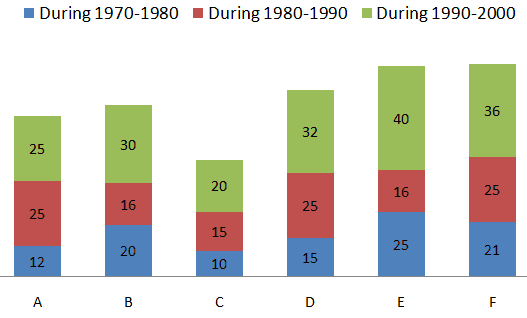- (27)^2 × 6 ÷ 9 + (7)^3 + 71 = (?)^3 – 431
1216111418Option C
(27)^2 × 6 ÷ 9 + (7)^3 + 71 = (?)^3 – 431 =>(729 × 6 ÷ 9) + 343 + 71 + 431 = x^3 => 486 + 343 + 71 + 431 = x^3 => x ^3 = 1331 =>x = 11 - 87.5% of 3888 – 462 × 6 = ? % of 4200
1523201012Option A
87.5% of 3888 – 462 × 6 = ? % of 4200 =>87.5% of 3888 – 462 × 6 = ? % of 4200 => 3402–2772 = x/100 × 4200 =>630 = 42x =>x = 15 - 12.5% of 9600 – 16.67% of 3240 = 33% of ?
20001110225020102550Option A
12.5% of 9600 – 16.67% of 3240 = 33% of x =>33% of x = 9600/8 – 3240/6 => 33% of x = 1200–540 =>x = 660×100/33 => x = 2000 - 150% of 5/8 of x = 75% of 1250
12501320110014401000Option E
150% of 5/8 of x = 75% of 1250 =>150% of 5/8 of x = 75% of 1250 => x = 1000 - 24.92% of 1504 + 44.88% of 804 = ?
777735720700715Option B
24.92% of 1504 + 44.88% of 804 = ? => 25/100 ×1500 + 45/100 ×800 = 375 + 360 = 735 - If the population of City D is 2087250 in the the year 2000, what was its population in the year 1970?
20 lakh5 lakh15 lakh11 lakh10 lakhOption D
Population(1970) =2087250* 100/115* 100/125* 100/132 = 11 lakh - If the population of City E and City F in the year 1970 was 12.5 lakh and 10 lakh respectively, what is the difference between the population of City E and the population of City F in the year 2000?
4.102 lakh2.115 lakh3.303lakh4.805 lakh2.105 lakhOption D
E(2000) = 12.5* 125/100* 116/100* 140/100 = 25.375 lakh F(2000) = 10* 121/100* 125/100* 136/100 = 20.57 lakh Difference = 25.375 – 20.57 = 4.805 lakh - If the population of City C and that of City D were equal in the year 1970, what is the ratio of the population of City C to that of City D in 1990?
21:2322:2518:1917:2119:22Option B
Let the population of City C and City D be x at the beginning of 1970. Population-C1990 = x *110/100* 115/100 Population-D1990 = x *115/100* 125/100 Ratio = 110/125 = 22/25 - If the population of City C was 8.5 lakh in the year 1970, what is the population of City C in the year 2000?
12.903 lakh10.812 lakh14.145 lakh11.503 lakh10.905 lakhOption A
Population = 8.5* 110/100* 115/100* 120/100 = 12.903 lakh - If, in the year 2000, the populations of City A and B are 1388800 and 1302912 respectively, the population of City B in the year 1970 was what percentage of the population of City A in the year 1970?
100%60%90%70%80%Option C
Population-A1970 1388800* 100/112* 100/124* 100/125 = 8 lakh Population-B1970 1302912* 100/120* 100/116* 100/130 = 7.2 lakh Required percentage = 7.2/8 × 100 = 90%
Directions(6-10): Following graph shows the percentage growth of population of six cities (A, B, C, D, E and F) in three decades.


Thanks for your publiction. Another factor is that being photographer includes not only difficulties in recording award-winning photographs but also hardships in acquiring the best photographic camera suited to your requirements and most especially hardships in maintaining the caliber of your camera. This can be very accurate and apparent for those photography lovers that are straight into capturing the actual nature’s eye-catching scenes : the mountains, the forests, the actual wild and the seas. Visiting these daring places undoubtedly requires a photographic camera that can live up to the wild’s harsh areas.
It’s a shame you don’t have a donate button! I’d most certainly donate to this brilliant blog!
I guess for now i’ll settle for book-marking and adding your RSS
feed to my Google account. I look forward to fresh updates and will talk about this site with
my Facebook group. Chat soon!